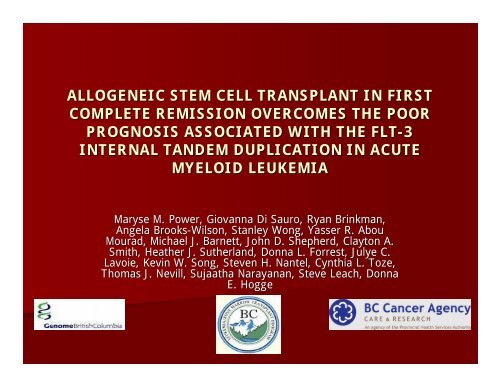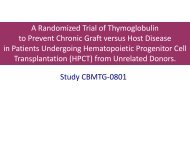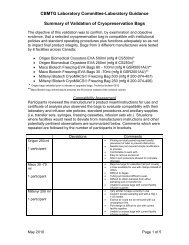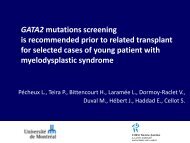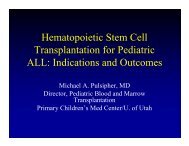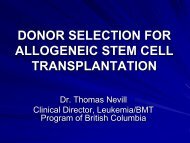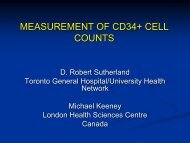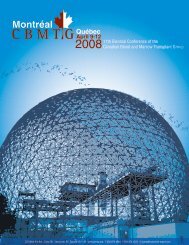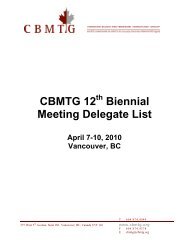Maryse Power - CBMTG
Maryse Power - CBMTG
Maryse Power - CBMTG
Create successful ePaper yourself
Turn your PDF publications into a flip-book with our unique Google optimized e-Paper software.
ALLOGENEIC STEM CELL TRANSPLANT IN FIRST<br />
COMPLETE REMISSION OVERCOMES THE POOR<br />
PROGNOSIS ASSOCIATED WITH THE FLT-3<br />
INTERNAL TANDEM DUPLICATION IN ACUTE<br />
MYELOID LEUKEMIA<br />
<strong>Maryse</strong> M. <strong>Power</strong>, Giovanna Di Sauro, Ryan Brinkman,<br />
Angela Brooks-Wilson, Stanley Wong, Yasser R. Abou<br />
Mourad, Michael J. Barnett, John D. Shepherd, Clayton A.<br />
Smith, Heather J. Sutherland, Donna L. Forrest, Julye C.<br />
Lavoie, Kevin W. Song, Steven H. Nantel, Cynthia L. Toze,<br />
Thomas J. Nevill, Sujaatha Narayanan, Steve Leach, Donna<br />
E. Hogge
Introduction<br />
• Prognosis in AML –Karyotype powerful<br />
prognostic indicator AND helps to guide<br />
therapeutic decisions<br />
• Most patients fall into the “intermediate risk”<br />
karyotype group (46-74% of patients), with 40-<br />
50% of patients displaying a normal karyotype<br />
at diagnosis<br />
• Newly identified molecular abnormalities add<br />
further prognostic information in this group.
Survival-Cytogenetic Risk Group<br />
HETEROGENOUS
Impact of FLT3 mutations on<br />
outcome in AML<br />
Thiede, C. et al. Blood 2002;99:4326-4335
NPM1 mutation status and<br />
AML outcome<br />
Dohner, K. et al. Blood 2005;106:3740-3746
Aim<br />
• Define prevalence, prognostic significance<br />
of mutations in FLT3 and NPM1 in a<br />
cohort of AML patients under the age of<br />
60 years in first complete remission<br />
• Compare the results obtained using<br />
allogeneic SCT in first CR to chemotherapy<br />
consolidation in FLT3 and nucleophosmin<br />
mutated patients
Patient Characteristics<br />
• Patients treated at Vancouver General Hospital<br />
between 1980 and 2006<br />
• All had achieved complete remission with one or<br />
two cycles of induction chemotherapy<br />
• Retrospective analysis<br />
• Treatment decisions not based on molecular<br />
data
Patients<br />
Database identified 695 patients with diagnosis of AML who<br />
achieved CR1 with one or two cycles of induction therapy and<br />
were aged < 60 years<br />
298 patients of this group had sufficient DNA in diagnostic<br />
samples available for analysis<br />
Further 31 patients excluded for clinical reasons: eg; failure to<br />
achieve CR per Cheson criteria, MDS diagnosis rather than<br />
AML, No therapy given beyond CR1<br />
267 patients in final group
Patients<br />
230 patients<br />
ALLO SCT in CR1<br />
n=92<br />
Chemo in CR1<br />
N=138
Patient Characteristics<br />
• CHEMO Group<br />
– Of the CHEMO group, 92% received high dose ARA-C<br />
consolidation therapy<br />
– 86% received more than one cycle of chemotherapy<br />
consolidation<br />
– This group included 9 patients who were treated with<br />
autologous SCT in first CR as consolidation therapy
Patient Characteristics<br />
• ALLO Group (n=92)<br />
– 62 patients SIB ALLO<br />
– 22 patients VUD with full HLA match<br />
– 7 patients with mismatch VUD<br />
– 1 haploidentical
Results<br />
• FLT 3 ITD mutation in 24% of patients<br />
(41% of normal karyotype group)<br />
• Nucleophosmin NPM1 mutation in 28% of<br />
patients (47% of normal karyotype group)<br />
• FLT 3 D835 point mutation in 9% of the<br />
total group
Entire Group: ALLO vs CHEMO
Survival- Induction Failure
Survival-Cytogenetic Risk Group
Overall Survival- All Patients<br />
According to FLT3 ITD Status
Intermediate Risk (IR) Group-<br />
FLT3 ITD Status
IR Group- NPM1 and FLT3<br />
D835 Mutation Status and OS
Interaction of FLT3 ITD and<br />
NPM1 Mutation with OS
Survival<br />
• 50% of FLT3 ITD positive patients are alive<br />
following ALLO SCT in CR1<br />
• 30% of FLT3 ITD positive patients are alive<br />
following CHEMO consolidation in CR1<br />
• Relapse rate: 39% in ALLO SCT in CR1<br />
76% in CHEMO in CR1
Intermediate Risk Cytogenetics-<br />
Allograft group
Intermediate Risk Cytogenetics<br />
Group- CHEMO
ITD Positive Patients- CHEMO vs<br />
ALLO
Conclusions<br />
• Mutations in FLT3 and NPM1 - similar<br />
prevalence in our cohort to other groups<br />
• Induction failure, cytogenetic classification<br />
and FLT3 ITD mutation status predictive<br />
of overall survival<br />
• No effect of NPM1 or FLT3 D835 mutation<br />
on overall survival
Conclusions<br />
• Higher relapse risk in AML patients with<br />
FLT3 ITD treated with chemotherapy in<br />
CR1<br />
• Negative prognostic effect of the FLT3 ITD<br />
appears to be overcome by allogeneic SCT<br />
in CR1
Acknowledgments<br />
• Leukemia and BMT Program of BC/ BC Cancer Agency<br />
• Dr Donna Hogge MD,PhD<br />
• Giovanna di Sauro BCCRC, Angela Brooks Wilson, BC<br />
Centre for Genome Science<br />
• Ryan Brinkman, Stanley Wong, Yunfeng Dai, BCCRC<br />
• Janet Nitta and Roomana Bajwa, Data Coordinators VGH


